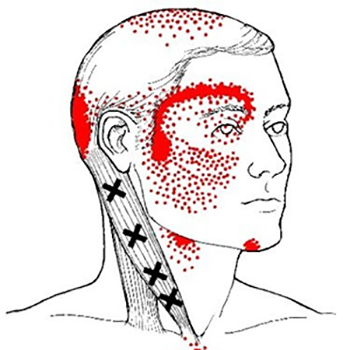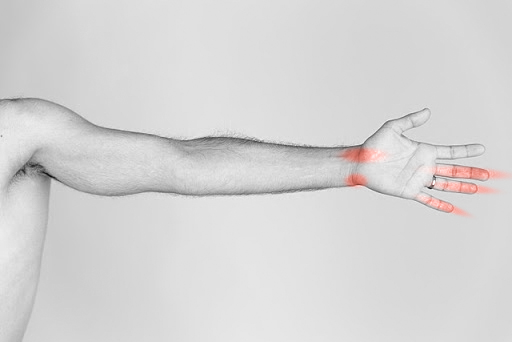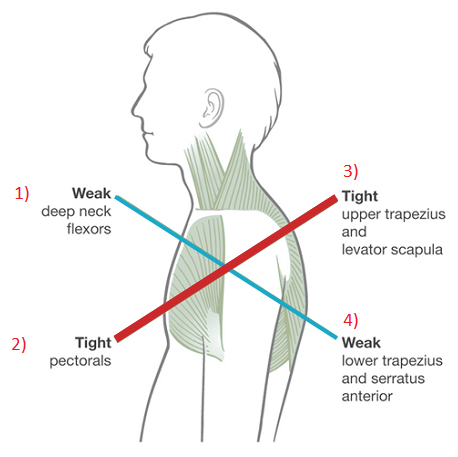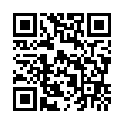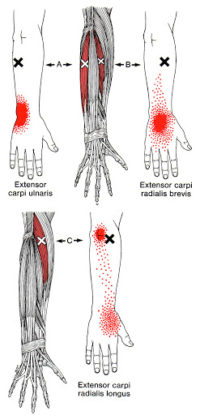 The extensors of the hand and the wrist include extensor carpi ulnaris, extensor carpi radialis longus, and extensor carpi radialis brevis. All three run most of the length of the forearm. Collectively, along with brachioradialis, they extend the hand at the wrist. Their chief function is to prevent wrist flexion, working synergistically with the finger flexors, during hand grasp.
The extensors of the hand and the wrist include extensor carpi ulnaris, extensor carpi radialis longus, and extensor carpi radialis brevis. All three run most of the length of the forearm. Collectively, along with brachioradialis, they extend the hand at the wrist. Their chief function is to prevent wrist flexion, working synergistically with the finger flexors, during hand grasp.
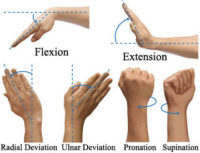 The extensor carpi radialis longus deviates the hand to the thumb side at the wrist. The extensor carpi ulnaris deviates the hand at the wrist to the pinky side.
The extensor carpi radialis longus deviates the hand to the thumb side at the wrist. The extensor carpi ulnaris deviates the hand at the wrist to the pinky side.
Pain from extensor carpi radialis longus and brevis trigger points resembles brachioradialis referrals. They occur on the outside of the forearm, near the elbow, and progress down the arm toward the base of the thumb and hand.
Extensor carpi ulnaris trigger points are uncommon but refer to the top, base of the hand on the pinky side. They occur most often after gross trauma or a frozen shoulder syndrome.
 Hand extensor trigger points are typically activated from a combination of repetitive, forceful gripping, and twisting motions. This can include activities as diverse as weeding, using a screwdriver or handwriting. Once initial soreness develops, the tendency to “test” the muscle for improvement tends to worsen it.
Hand extensor trigger points are typically activated from a combination of repetitive, forceful gripping, and twisting motions. This can include activities as diverse as weeding, using a screwdriver or handwriting. Once initial soreness develops, the tendency to “test” the muscle for improvement tends to worsen it.
The functional unit of the hand extensors includes the brachioradialis. Corrective actions include trigger point pressure release, stretching, and avoiding activities that overload the muscle.
 If you maintain a posture or activity that activates a trigger point in any muscle it will continue.
If you maintain a posture or activity that activates a trigger point in any muscle it will continue.
Hand extensor trigger points are typically activated from a combination of repetitive, forceful gripping, and twisting motions. This can include activities as diverse as weeding, using a screwdriver, or handwriting. Once initial soreness develops, the tendency to “test” the muscle for improvement tends to worsen it. Playing guitar or bass guitar can place the hand on the neck at a disadvantage. 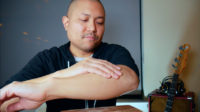
The hand extensors are more vulnerable when your wrist is flexed or deviated to the pinky side. For example, an improper grip on a tennis racquet or a baseball bat can contribute to hand extensor trigger point activations.
With “tennis elbow”, hand extensor trigger points can develop after a supinator (forearm rotator) activation, along with trigger points in the biceps and triceps.
Once initial soreness develops, the tendency to “test” the hand extensors for improvement tends to worsen the problem. Placing any muscle in a shortened or lengthened position for an extended period of time can also activate trigger points in the muscle. This happens most often when we are sleeping.
Myofascial self-care always starts with establishing a foundation of diaphragmatic breathing. Once you have taken a few moments to get in touch with your breath, we move on to self-compression and stretching. You may find that a warm bath or shower, or applying moist heat before you begin is helpful.
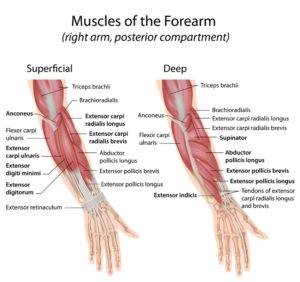 You can use pressure self-release for the wrist extensors while seated.
You can use pressure self-release for the wrist extensors while seated.
Using your hand from the unaffected side, begin by using your fist to gently massage the area just below the elbow. Explore the muscle, note areas that are sorer, and bring your focus to them.
 You can also use your elbow for sustained pressure without stressing your fingers. A series of glides lengthwise along the forearm can be effective.
You can also use your elbow for sustained pressure without stressing your fingers. A series of glides lengthwise along the forearm can be effective.
To compress specific trigger points, use the knuckle (or thumb) of the forefinger from the unaffected side to probe deeper. Find the tender spot and apply pressure for up to 30 seconds as pain decreases. You can do this three to five times.
Many blood vessels and nerves in the arm are superficial, so pressure self-release should be done with caution. If you feel tingling or circulation changes in your hand you should reposition and take a different approach.
After completing self-compressions, move your wrist through its range of motion and prepare to gently stretch your wrist extensors.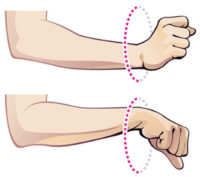
You can use your breath to deepen the wrist extensor stretch shown. Note that the fingers are extended in this stretch. You may also stretch with a loose fist, although this stretches the extensors of the fingers, not the wrist.
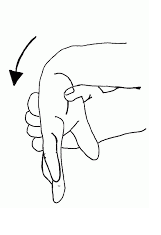 If you experience pain following pressure release and stretching, a cold pack may be helpful.
If you experience pain following pressure release and stretching, a cold pack may be helpful.
The video below discusses the role of the wrist extensors from a physical therapy perspective, including various forms of tendonitis. However, in many cases, such tendonitis resolves when you release the trigger points in your forearm:
Pain typically occurs at the base of the hand, on the top. Pain in the extensor carpi radialis longus refers to the base of the thumb and index finger. It may also cause pain along its length towards the elbow. The extensor carpi radialis brevis refers to the center of the hand and the extensor carpi ulnaris refers to the pinky side of the hand. Trigger points are not common in the extensor carpi ulnaris.
the base of the hand, on the top. Pain in the extensor carpi radialis longus refers to the base of the thumb and index finger. It may also cause pain along its length towards the elbow. The extensor carpi radialis brevis refers to the center of the hand and the extensor carpi ulnaris refers to the pinky side of the hand. Trigger points are not common in the extensor carpi ulnaris.
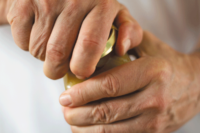 However, the most distinctive symptom of trigger points in the extensor radialis longus and brevis is a significant weakness when gripping. The larger the object you are grasping the more profound the weakness is. Weakness can be so severe that you cannot open an unsealed jar or grasp a carton of milk, for instance.
However, the most distinctive symptom of trigger points in the extensor radialis longus and brevis is a significant weakness when gripping. The larger the object you are grasping the more profound the weakness is. Weakness can be so severe that you cannot open an unsealed jar or grasp a carton of milk, for instance.
This weakness may also manifest as decreased coordination and stamina during repetitive hand flexion and wrist extension.
Hand extensor trigger points do not happen in isolation and are part of a pattern that includes the brachioradialis and arm flexors.
 Avoid repetitive actions that overload the muscle with your wrist flexed or deviated towards your pinky. , such as excessive hand flexion/gripping. You may consider adapting by deliberately rotating at the shoulder rather than moving your wrist at times.
Avoid repetitive actions that overload the muscle with your wrist flexed or deviated towards your pinky. , such as excessive hand flexion/gripping. You may consider adapting by deliberately rotating at the shoulder rather than moving your wrist at times.
Limit flexion and ulnar deviation of the wrist. Limit forceful rotation of the arm and rapid flexion/extension of the elbow. In sports activities, deliberately deviate your wrist toward the thumb side of your hand.
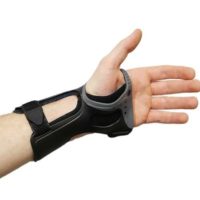 When engaging in activities involving forceful twisting motions or wrist flexion, use a wrist guard similar to below. They are often sold for carpal tunnel syndrome.
When engaging in activities involving forceful twisting motions or wrist flexion, use a wrist guard similar to below. They are often sold for carpal tunnel syndrome.
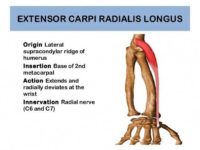 Extensor carpi radialis longus and brevis are extensors at the wrist joint and travels along the radial (thumb) side of the arm.
Extensor carpi radialis longus and brevis are extensors at the wrist joint and travels along the radial (thumb) side of the arm. 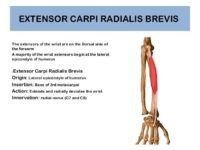 Because of this position, it also deviates the hand toward the thumb at the wrist.
Because of this position, it also deviates the hand toward the thumb at the wrist.
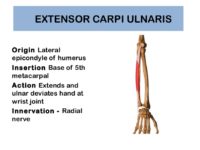 Extensor carpi ulnaris also extends the hand at the wrist, but when acting alone inclines the hand toward the ulnar (pinky) side. It also assists in extending the elbow-joint.
Extensor carpi ulnaris also extends the hand at the wrist, but when acting alone inclines the hand toward the ulnar (pinky) side. It also assists in extending the elbow-joint.
 All extensors of the forearm can be strengthened by exercise that resists its extension such as reverse wrist curls.
All extensors of the forearm can be strengthened by exercise that resists its extension such as reverse wrist curls.
 The hand/wrist extensors include the extensor carpi radialis longus and brevis and the extensor carpi ulnaris. runs from the lower third of the upper arm to the forearm.
The hand/wrist extensors include the extensor carpi radialis longus and brevis and the extensor carpi ulnaris. runs from the lower third of the upper arm to the forearm.
Extensor carpi radialis longus originates from the lower part of the humerus, from the lateral intermuscular septum, and by a few fibers from the lateral epicondyle of the humerus.
 The fibers end at the upper third of the forearm in a flat tendon, which runs along the radius (thumb side), beneath the muscles of the thumb. It then passes beneath the dorsal carpal ligament, immediately behind the styloid process.
The fibers end at the upper third of the forearm in a flat tendon, which runs along the radius (thumb side), beneath the muscles of the thumb. It then passes beneath the dorsal carpal ligament, immediately behind the styloid process.
It initially lies beside the brachioradialis, but then becomes mostly tendon. Passing between the brachioradialis and the extensor carpi radialis brevis, this tendon continues together with the brevis.
It is inserted into the top surface of the base of the second metacarpal bone.
 Extensor carpi radialis brevis originates from the lateral epicondyle of the humerus, by the common extensor tendon; from the radial collateral ligament of the elbow-joint; from a strong aponeurosis which covers its surface; and from the intermuscular septa between it and the adjacent muscles. That means that it is powerfully connected to the bone of the upper arm, the connective tissue of the elbow joint, and myofascial tissue of the forearm.
Extensor carpi radialis brevis originates from the lateral epicondyle of the humerus, by the common extensor tendon; from the radial collateral ligament of the elbow-joint; from a strong aponeurosis which covers its surface; and from the intermuscular septa between it and the adjacent muscles. That means that it is powerfully connected to the bone of the upper arm, the connective tissue of the elbow joint, and myofascial tissue of the forearm.
The muscular fibers end at the middle of the forearm in the form of a flat tendon, which is closely connected with that of the extensor Encarpi radialis longus, continuing together to the wrist. It passes beneath the muscles of the thumb, beneath the extensor retinaculum, and inserts into the top of the base of the third metacarpal bone, with a few fibers inserting into the top surface of the second metacarpal bone.
Extensor carpi ulnaris originates from the lateral epicondyle of the humerus and the posterior border of the ulna and crosses the forearm to the ulnar (pinky) side to insert at the base of the 5th metacarpal.
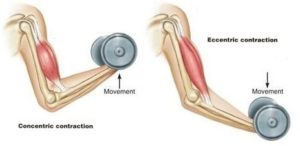 For example, in a biceps curl, you would use a concentric contraction of your biceps, coupled with an eccentric contraction of your triceps, to flex your elbow and push the weight up. As you lower the weight, eccentric contractions of your biceps are required to maintain control and prevent dropping the weight.
For example, in a biceps curl, you would use a concentric contraction of your biceps, coupled with an eccentric contraction of your triceps, to flex your elbow and push the weight up. As you lower the weight, eccentric contractions of your biceps are required to maintain control and prevent dropping the weight.
Isotonic Contractions
Isotonic contractions maintain constant tension in the muscle as the muscle changes length. This can occur only when a muscle’s maximal force of contraction exceeds the total load on the muscle. Isotonic muscle contractions can be either concentric (muscle shortens) or eccentric (muscle lengthens).Concentric Contractions
A concentric contraction is a type of muscle contraction in which the muscle shortens while generating force. This is typical of muscles that contract due to the sliding filament mechanism, and it occurs throughout the muscle. Such contractions also alter the angle of the joints to which the muscles are attached.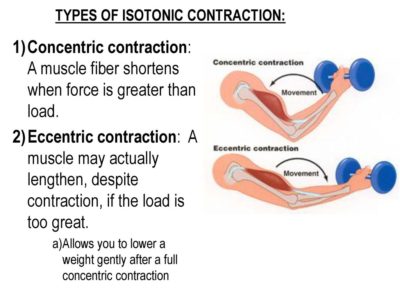 This occurs throughout the length of the muscle, generating force; causing the muscle to shorten and the angle of the joint to change. For instance, a concentric contraction of the biceps would cause the arm to bend at the elbow as the hand moves close to the shoulder (a biceps curl).
A concentric contraction of the triceps would change the angle of the joint in the opposite direction, straightening the arm and moving the hand away from the shoulder.
This occurs throughout the length of the muscle, generating force; causing the muscle to shorten and the angle of the joint to change. For instance, a concentric contraction of the biceps would cause the arm to bend at the elbow as the hand moves close to the shoulder (a biceps curl).
A concentric contraction of the triceps would change the angle of the joint in the opposite direction, straightening the arm and moving the hand away from the shoulder.
Eccentric Contractions
An eccentric contraction results in the lengthening of a muscle. These contractions decelerate muscles and joints (acting as “brakes” to concentric contractions) and can alter the position of the load force. During an eccentric contraction, the muscle lengthens while under tension due to an opposing force that is greater than the force generated by the muscle. However, rather than working to pull a joint in the direction of the muscle contraction, the muscle acts to decelerate the joint at the end of a movement or otherwise control the repositioning of a load. This can occur involuntarily (when attempting to move a weight too heavy for the muscle to lift) or voluntarily (when the muscle is “smoothing out” a movement). Strength training involving both eccentric and concentric contractions appears to increase muscular strength and joint stability more than training with concentric contractions alone.Isometric Contractions
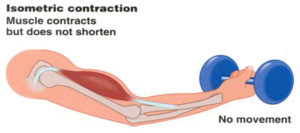 In contrast to isotonic contractions, isometric contractions generate force without changing the length of the muscle. This is typical of muscles found in the hands and forearm: the muscles do not change length, and joints are not moved, so force for grip is sufficient. An example is when the muscles of the hand and forearm grip an object; the joints of the hand do not move, but muscles generate sufficient force to prevent the object from being dropped.
For people with hypermobile joints, strength training can be a challenge. Tension stresses the connective tissues of the joint as force is transmitted through its range of motion. Isometric exercises can be ideal in these circumstances because there is minimal movement. This means that the joint is placed into vulnerable hyperextended positions under force.
In contrast to isotonic contractions, isometric contractions generate force without changing the length of the muscle. This is typical of muscles found in the hands and forearm: the muscles do not change length, and joints are not moved, so force for grip is sufficient. An example is when the muscles of the hand and forearm grip an object; the joints of the hand do not move, but muscles generate sufficient force to prevent the object from being dropped.
For people with hypermobile joints, strength training can be a challenge. Tension stresses the connective tissues of the joint as force is transmitted through its range of motion. Isometric exercises can be ideal in these circumstances because there is minimal movement. This means that the joint is placed into vulnerable hyperextended positions under force.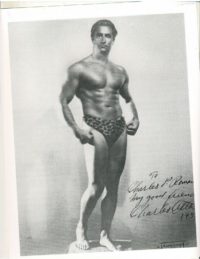 You can develop amazing strength without free weights, machines, or resistance bands.
One of the original bodybuilder gurus from the 1920s, Charles Atlas, based his workouts primarily on isometric exercises, eventually even trademarking a term for his exercise method that he called "Dynamic Tension."
If you have hypermobile joints you can strength train safely at home with isometric exercises.
You can develop amazing strength without free weights, machines, or resistance bands.
One of the original bodybuilder gurus from the 1920s, Charles Atlas, based his workouts primarily on isometric exercises, eventually even trademarking a term for his exercise method that he called "Dynamic Tension."
If you have hypermobile joints you can strength train safely at home with isometric exercises.
Professional Treatment With Us
Take some time. Treat yourself. You deserve it.
Book a treatment this month and receive 20% off a three session package.
Janet was great. FANTASTIC person who knew how to treat and deal with my conditions. Very informative. Finally, someone who knew what I was talking about.
Really Good
It was interesting, and helpful for my IT band and hip
My experience was wonderful. Janet was very kind and attentive. I felt great after my session and would recommend to try it out.
The lady that assisted me was awesome! I suffer from fibromyalgia and when I left I felt like a brand new person! I plan to return when I get time!
Janet was great - knowledgeable and she found all my "hot spots."
Seriously, if you are looking for massage therapy that actually does your body good--that changes its function for the better and actually makes pain go away--then this is the place you need to come. Not Massage Envy. Not a chiropractor. You need trigger point from knowledgeable experts in the craft.
If your have pain in any part of your body this is the place to go. It focus on the muscles where the pain is. you will feel like a new person. Awesome will be returning. Thanks nice friendly and attentive
amazing!!!
I felt so much better after my appointment. Thank you and thanks for the self care tips!
Experienced therapist. Feel great after appointment...
Highly recommended!
What a great experience. The provider was able to recommend things I can do to improve my pain. Address issues I didn't even share with her that she was able to tell just by her exam and treating me for what i went for. Will be back. Feeling grateful
I spent so much money on chiropractors. This is much better. Everybody should try it out.
Beautiful, relaxing setting. Therapist was knowledgable and professional. I'll be going back. Thank you.
Janet is very informative. I loved that she explained which muscles/groups she was working on. I learned a lot about my posture and why some of my muscles are not activating. She also provided me with a list of considerations and excercises to improve my posture. I will be back!
Janet has a unique gift and talent in trigger point therapy. I’m definitely seeing her again!
I loved my experience. Janet is extremely knowledgeable in a vary wide variety of conditions. She is thorough and attentive. Makes you feel right at home!
It's like an hour of physical therapy (the good parts of P.T. where they massage you and stretch you). She also takes time to explain some ways to help your specific issues. Highly recommend!
Janet is very knowledgeable and informative. She thoroughly explains where you have weakness and what muscles are over compensating. She gives exercises, stretches, or everyday changes you can make to help you are progress on your own. I highly recommend a visit!
Janet was very knowledgeable and never in a hurry. She took her time explaining every little detail, great service
Felt much better after the trigger point massage, highly recommend.
Excellent
What About My Pain?
Clearly, everyone is different. Many of us have additional challenges and complications. Naturally, we tailor our treatment plans to the individual. However, there are common foundations in this work with everyone.
Fortunately, if you are having similar issues, you may find that a just few treatment sessions helps! We will identify and treat root causes of your individual case.
Clearly, everyone is different. Many of us have additional challenges and complications. Naturally, we tailor our treatment plans to the individual. However, there are common foundations in this work with everyone.
We are licensed professionals. In addition, we all have additional training and certifications in advanced techniques. For instance, this includes trigger point therapy, fascial stretching, neuromuscular and movement therapy. Also we offer kinesio taping, myofascial release, cupping, acoustic compression, self-care classes and more. In fact, we often combine several of these techniques into a single session..
Of course, no one wants chronic pain! Fortunately, can work together with you to help sort out the issues.
Click here or all us at 630-858-0000 today to make an appointment!
More info at: WestSubPainRelief.com
You can also take a picture of this QR code with another phone and share or view the entire article:
If reading from a pdf or printout, you will find links and videos at: https://WestSubPainRelief.com/hand-extensors-2

